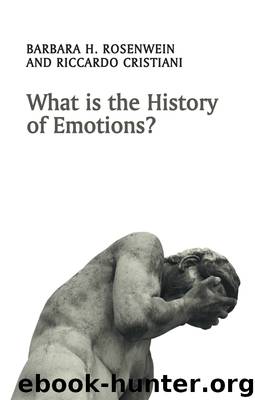What Is the History of Emotions? by Rosenwein Barbara H.; Cristiani Riccardo; & Riccardo Cristiani

Author:Rosenwein, Barbara H.; Cristiani, Riccardo; & Riccardo Cristiani
Language: eng
Format: epub
Publisher: Polity Press
Published: 2018-01-13T16:00:00+00:00
The gendered body
If defined by different sex organs, bounded and autonomous bodies come in genders, and, indeed, the earliest studies of gender took physical distinctions as an unproblematic given. An outgrowth of the women's movements of the 1960s and 1970s, gender studies began before the history of emotions took off. In its first phase, it simply took notice of the existence of women in history. Previously, historians had focused either on men and their activities or – as in the Annales school – on the social, economic, political, and geographical structures that underlay the sorts of things that mainly men did. The earliest studies to focus on women celebrated female artists, saints, queens, and Nobel prize winners – the “great woman” view of history. Or they considered the various roles – weavers, spinners, beer brewers, factory workers – that even nameless women had played in the past. These studies challenged the prevailing narrow definitions of both politics and power.18
Meanwhile, psychologists, too, were breaking away from their fixation on the male subject by looking at females as well. In the 1970s, the American Psychological Association set up a division on the Psychology of Women. Around the same time, Stephanie Shields, a pioneer in the field, wrote about “the psychology of women as it existed prior to its incorporation into psychoanalytic theory.” This psychology, as Shields pointed out, was derived from a Darwinian model. It emphasized “the biological foundations of temperament,” particularly “the maternal instinct,” which it treated as “innate.”19 Shields did not, however, critique the research done after 1960 and up to her own time. Had she done so, she would have observed that of 139 articles dealing with women and emotion published between 1960 and 1975, as many as 125 (i.e. 89 percent) dealt with the emotion of depression. Moreover, such studies overwhelmingly took up “female” issues, namely matters associated with reproduction. Abortion engendered anxiety and depression; gynecological operations led to depression, anxiety, and loss of libido; pre-menopause brought depression, sorrow, bitterness, and apathy; and so on.20
These were “essentialist” studies that understood “female,” and therefore “male,” as fixed categories. Nor did historians writing in the 1970s directly question that assumption. Nevertheless, they were interested in exploring more than reproductive or other woes, and they were open to the possibility that “female” emotional lives in the past differed from those of today. Thus, when Carroll Smith-Rosenberg wrote about female relationships in nineteenth-century America, she interpreted the women's passionately affectionate letters and diaries to one another not as “abnormal” or “homosexual,” but rather as part and parcel of a society that welcomed and valued same-sex love. The women whom she studied wed men, had children, and lived apart from one another. Yet their mutual love continued unabated. “My darling how I long for the time when I shall see you,” wrote one woman to a dear friend, using language that today we associate with erotic love. Smith-Rosenberg suggested that amorous feelings between women served an important social function, ratifying the “rigid gender-role differentiation within the family and within society as a whole.
Download
This site does not store any files on its server. We only index and link to content provided by other sites. Please contact the content providers to delete copyright contents if any and email us, we'll remove relevant links or contents immediately.
| Africa | Americas |
| Arctic & Antarctica | Asia |
| Australia & Oceania | Europe |
| Middle East | Russia |
| United States | World |
| Ancient Civilizations | Military |
| Historical Study & Educational Resources |
Underground: A Human History of the Worlds Beneath Our Feet by Will Hunt(11839)
Sapiens by Yuval Noah Harari(5123)
Navigation and Map Reading by K Andrew(4889)
The Sympathizer by Viet Thanh Nguyen(4095)
Barron's AP Biology by Goldberg M.S. Deborah T(3944)
5 Steps to a 5 AP U.S. History, 2010-2011 Edition (5 Steps to a 5 on the Advanced Placement Examinations Series) by Armstrong Stephen(3638)
Three Women by Lisa Taddeo(3278)
The Comedians: Drunks, Thieves, Scoundrels, and the History of American Comedy by Nesteroff Kliph(2994)
Water by Ian Miller(2953)
Drugs Unlimited by Mike Power(2484)
The House of Government by Slezkine Yuri(2103)
DarkMarket by Misha Glenny(2099)
A Short History of Drunkenness by Forsyth Mark(2067)
And the Band Played On by Randy Shilts(2014)
The Library Book by Susan Orlean(1999)
Revived (Cat Patrick) by Cat Patrick(1896)
The Woman Who Smashed Codes by Jason Fagone(1874)
The House of Rothschild: Money's Prophets, 1798-1848 by Niall Ferguson(1809)
Birth by Tina Cassidy(1803)
